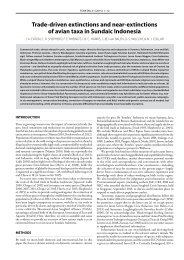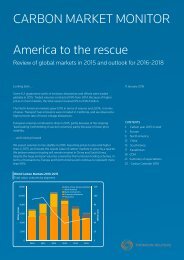Emissions Trading Worldwide
1TbjEHd
1TbjEHd
Create successful ePaper yourself
Turn your PDF publications into a flip-book with our unique Google optimized e-Paper software.
Brazil — São Paulo<br />
under consideration<br />
São Paulo was the first Brazilian state to adopt subnational climate<br />
change legislation in 2009. The policy establishes an economy-wide<br />
emissions reduction target and focuses on the energy,<br />
industrial processes, solvents, agriculture, and waste sectors. São<br />
Paulo has also established a GHG inventory. In 2012, the state<br />
announced plans to establish an ETS. However, the plan was put<br />
on hold for an undetermined time in 2014.<br />
background information<br />
GHG Reduction Targets By 2020: 20% reduction from 2005 GHG levels.<br />
other information<br />
Institutions involved The State Fund of Pollution Prevention and Control<br />
(FECOP), Secretariat for the Environment of the State of Sao Paulo, Companhia<br />
Ambiental do Estado de São Paulo (CETESB), Brazilian Mercantile & Futures<br />
Exchange (BM&F), São Paulo Stock Exchange (Bovespa) and the Centro de<br />
Estudos em Sustentabilidade Getulio Vargas (GVCes)<br />
Overall Ghg <strong>Emissions</strong> (excl. LULUCF) 139.8 MtCO 2 e (2005)<br />
OVERALL GHG EMISSIONS BY SECTOR<br />
MtCO 2 e<br />
14.7 % 21.3 % 6.7 %<br />
57.2 %<br />
Industrial processes (20.6)<br />
Agriculture 1 (29.8)<br />
waste (9.4)<br />
Energy (80.0)<br />
1 Excluding emissions from organic soils.<br />
Chile<br />
under consideration<br />
Under the PMR, Chile received funding to develop a roadmap for<br />
the design and eventual implementation of an ETS for GHG mitigation<br />
in the energy sector in March 2013. However, it subsequently<br />
shifted policy priorities towards the implementation of a carbon<br />
tax. The roadmap includes necessary institutional arrangements,<br />
regulatory options, economic impacts and technical requirements<br />
for an MRV framework to track GHG emissions that would fit both<br />
a carbon tax and an ETS.<br />
In September 2014, as part of a broader fiscal reform Chile<br />
approved the carbon tax for thermal power generators with a thermal<br />
input equal to or above 50 MW. Power plants based on biomass<br />
are exempted. From 2017 on, emitters will have to pay USD 5<br />
(EUR 4) for related CO 2 emissions; the tax level for particulate matter,<br />
NO x and SO 2 emissions that are also covered by the tax is yet<br />
to be determined. In the longer run, Chile is still considering the<br />
transition to an ETS.<br />
In addition to its mandatory mitigation policies, Chile has<br />
a track record of activities in the voluntary carbon market.<br />
Established in 2009, the Santiago Climate Exchange provides<br />
a local platform for trading voluntary GHG reductions. In addition,<br />
the Chilean government established a “Platform for the<br />
Generation and <strong>Trading</strong> of Carbon Credits from the Forestry Sector<br />
in Chile” in January 2013. The platform works in cooperation with<br />
Verified Carbon Standards, a major GHG program in the global voluntary<br />
carbon market.<br />
background information<br />
Overall Ghg <strong>Emissions</strong> (excl. LULUCF) 91.6 MtCO 2 e (2010)<br />
OVERALL GHG EMISSIONS BY SECTOR<br />
MtCO 2 e<br />
6.1 % 15.1 % 3.9 % 50.9 %<br />
1.3 %<br />
Industrial processes (5.6)<br />
Agriculture (13.8)<br />
waste (3.6)<br />
Energy (excl. transp.) (46.6)<br />
fugitive emissions,<br />
Solvents & other (1.2)<br />
Transport (20.8)<br />
22.7 %<br />
GHG Reduction Targets By 2020: Under the UNFCCC and conditional to<br />
external support, Chile has pledged to reduce projected BAU emissions by<br />
20% compared to 2007 levels. By 2030: 30% reduction of emissions intensity<br />
compared to 2007, in terms of CO 2/unit of GDP. Conditional to international<br />
funding, 35–45% reduction of emissions intensity compared to 2007, in terms<br />
of CO 2/unit of GDP.<br />
other information<br />
Institutions involved Ministry of Energy, Ministry of the Environment,<br />
Ministry of Finance, Inter-Ministerial Committee on Climate Change<br />
48




